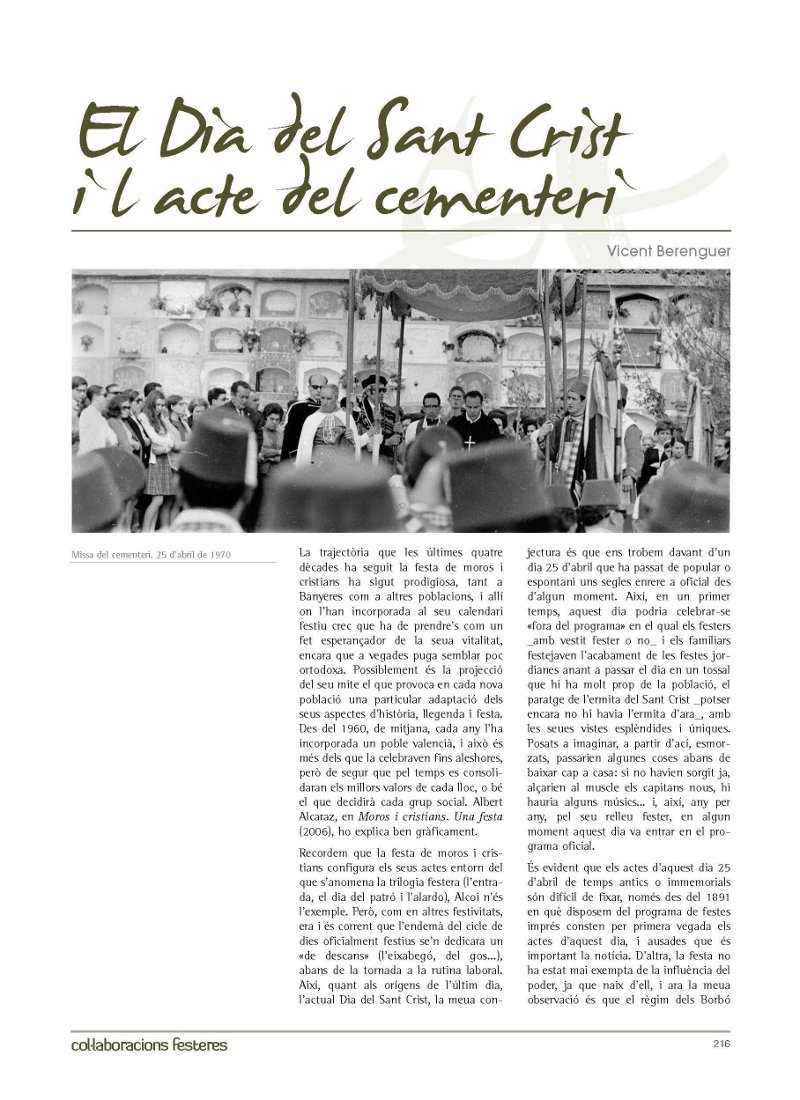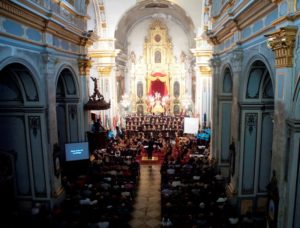The Moors and Christians festival has been marvelous over the last four decades, both in Banyeres and in other towns, and where they have incorporated it into their festive calendar I think it should be taken as a hopeful fact of their vitality, although at times it may seem unorthodox. It is possibly the projection of its myth that causes in each new population a particular adaptation of its aspects of history, legend and party. From 1960, on average, every year it is incorporated by a Valencian people, and this is more than those who celebrated it until then, but surely the best values of each site will consolidate over time, or what each social group will decide. Albert Alcaraz, in Moors and Christians. A party (2006), explains it graphically.
Recall that the Moors and Christians festival shapes its events around what is called the festive trilogy. (the entrance, the day of the skipper and the alardo), Alcoy is an example. But, as in other festivals, it was and is commonplace for the day after the official holidays cycle to have a 'rest' (drove it, of the dog…), before returning to work routine. Like this, as to the origins of the last day, the current day of the Holy Christ, My guess is that we are facing one day 25 of April that has gone from popular or spontaneous centuries ago to official since some time. Like this, at first, this day could be celebrated `` out of program '' in which festers - dressed in fester or not - and family members celebrated the end of the Jordanian festivities by spending the day on a hill near the town, the place of the hermitage of the Holy Christ _perhaps there was not the hermitage of now_, with its splendid and unique views. Put to imagine, from here, breakfast, a few things would happen before heading home: if they had not arisen already, they would lift the new captains on the shoulder, there would be some musicians… i, like this, any per any, by his relief fester, at some point that day it entered the official program.
Clearly the acts of this day 25 April or ancient times are difficult to pin down, only from the 1891 in which we have the printed party program, for the first time the events of this day are recorded, and daring that the news is important. On the other, the party has never been free from the influence of power, since he is born of him, and now my observation is that the Bourbon regime (1707) would mark this day, but this cannot be simplified, neither easily nor briefly. Centuries ago, the setting of festive events was not conceived in the same way as in recent decades, when all at once we find that we have reached an optimum party program of the day. 25 d'abril: flags dance at the Morer, height of new captains, shot to the Holy Christ, you save in the hermitage of Sant Jordi (formerly old cemetery), Mass at the cemetery and breakfast at Holy Christ, height of captains, shot inside the Malena, Stripping (o Conversion of the Moor into a Christian), ball moro, shot towards the Plaza Mayor, flags dance, relocation of the santjordiets…
The places have their importance, it is not the same breakfast in the Holy Christ as in the Mill the Shade… But if we accept, as it seems, that in its own way the Fiestas de Sant Jordi are celebrated well since the saint was established as the patron saint of the site in the 13th century., and that they revive in the xvii, for the expulsion of the Moors, It does not seem to me to conjecture that he will always have breakfast on that hill, to the Holy Christ, as "stingray day", the day after Moors and Christians Day. We find that the first reference of this building is of the 1775, year in which the Calvary was founded between the hermitages of Santa Maria Magdalena and the Sant Crist (Berenguer Mora, Bañeres and San Jorge, that. 1920; 2a ed. 1982). Later, the 1790 The inventory of all the religious buildings of the town also includes the hermitage of the Holy Christ (Ministry of Foreign Affairs, Royal Order 18-4-1790; Look Calatayud, First centenary of the hermitage of Santo Cristo, 2004). And the 1793, the two chapels are distinguished in the famous engraving of Cavanilles (Observations… from Reyno de Valencia, 1797). It also makes the case to state that, between 1734-1752, The current parish church is being built in the Plaza Mayor, the primitive on the site of the current Principal Theater has been disrupted, built at the beginning of the 20th century, a theater that already replaced the then-known Celler Sant Jordi, a wine-producing cooperative that would have been active since the early church was disaffected.
It seems that, Indeed, the mentioned constructions are erected in the hundred, an age of transformations, in the context of the Bourbon reign (1707), a regime that did not fall short of the illustrated ideas that have unequal luck affecting Spanish society, supported mainly by the good economic moment that the American colonies provide, although effective industrialization cannot be promoted, as it happens in England or Germany. The signs of political power, with all, they manifest and are forceful, both in the old Kingdom of Valencia and everywhere. But as we open the field of observation, the time is better understood, In Banyeres there is a chapel and a new temple, but in Lleida, to put a case for the significant, Charles III, the 1761, he builds a new factory headquarters as compensation for the military occupation of the old headquarters, of the 1278, that he 1707 it was about to be destroyed by the Franco-Spanish troops of Philip V, It was transformed into a military fortress until just a few years ago. Here, the instruction of the Secretary of the Council of Castile (1707): «So that the effect is achieved, without notice the care », it was of little use. For that, the construction of ordeals and hermitages of the Holy Christ, among others, represent some interventions of Bourbon politics, which in some cases will bring back previous devotions or festivals. In the case of Banyeres de Mariola, it is clear that St. George resisted the thrust and the Holy Christ, as seen, ended up joining the official program of the last holiday day. There is no denying it, of course, disaffection to Christ, for until the sixties there were still votes cast in his sacristy, but it is only in the 1963 when the brotherhood is created, at the suggestion of the priests José Soler and Francisco Asensi, and the 1991 when the gold book opens to record the height of the captains.
Otherwise, we find that the summer of 2008, and it cannot be accidental, in Atzeneta d'Albaida they celebrated the 300th anniversary of the feast of the Holy Christ, the most important festival of the population. Considered the case of this population, I find myself led to imagine _ doing historical fiction_ that day 25 d'April 1707 such as that of 1708, The first anniversary of the Bourbons' regime will have been one of the most unique days in the history of the Fiestas de Sant Jordi for the Banyeres. It is easy to imagine that more Bourbon-centricist patriotism should manifest itself that day, jacobí_ of the imaginable, because it would be impossible to go to breakfast on the hill of the then probably Proto-Sant Crist and to remain immune seeing on the horizon the fields of Cabdet and Almansa. Of course, these are personal guesses - not to mention Alfonso Danvila's Almansa, 1940—, but it is logical that, for Banyeres, "His victory of Almansa" will affect, that would produce some change in the festers, relatives or local authorities. The defeat of the Austrians was no more regime change. And it is certain that the relations of the Bourbon era are investigated (and other political periods) we will get to know some social aspects and the Moors and Christians better.
These last months, the initiative to propose that the act of the cemetery be of cultural interest has received unanimous support from the associations of Banyeres de Mariola and, certainly, from all over the neighborhood. The Moors and Christians holidays, in honor of Saint George, they cause such phenomena. Sometimes some controversy, but they always generate deep admiration, and ensure that its capacity for integration, at the end, it brings undoubted human enrichment.
And above all, let us have a thought for the dead, at least once a year, and a thought for death, a lot of times. Death has always distressed men, and when we look at the cemetery we understand that everything is not bones and ash, flowers and memory also count, and the thought for those who lived with us, that this is the root of human thought and the possibility of smiling. It seems to me that, like this, remembering these ideas by Joan F. Look, the feelings convened by the act of the cemetery are clearly expressed.











